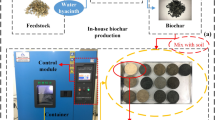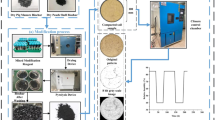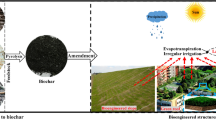Abstract
Purpose
Biochars produced from different feedstocks (such as wood, pig manure) possess varying physical and chemical properties, which have influence on crack and evaporation rate of biochar-amended soil (BAS). Furthermore, influence of compaction state and drying-wetting cycles on evaporation rate and cracking of BAS has not been investigated comprehensively. The objective of this study was to investigate the effects of biochar types, compaction state of BAS, and drying-wetting cycles on crack propagation and retained water (or evaporation rate).
Material and methods
An animal and plant feedstock-based biochars were produced in-house from pig manure (PM) and wood (W), respectively. In addition, nano structured chalk and wheat biochar (CWB) were also produced. Soil amended with individual biochars was compacted in petri-glass discs at two densities. Disc specimens were subjected to multiple drying-wetting cycles, and evaporation rate of specimens and crack area were monitored throughout the experimental period (70 days). Images were captured after every 24 h and processed using image processing technique to obtain the crack intensity factor (CIF).
Results and discussion
The results show that plant-based W BAS showed the high water retention, i.e., low evaporation rate and low CIF. Furthermore, the crack potential of CW BAS was seen to be higher. In dense compacted soil, maximum CIF% can be reduced from 3.9 to 0.4% for W BAS, from 3.9 to 1.7% for PM BAS, and from 3.9 to 1.6% for CW BAS.
Conclusion
WB was able to resist cracking more efficiently than other types of biochar. Evaporation was found to be minimal for plant-based W BAS at 10% biochar percentage. Higher biochar content in soil was seen to increase the water retention of BAS significantly. Dense state of BAS at high biochar content (i.e., 10%) was effective in reducing evaporation rate and crack progression.











Similar content being viewed by others
Abbreviations
- ASTM:
-
American Society of Testing and Materials
- BAS:
-
Biochar amended soil
- CIF:
-
Crack intensity factor
- CW:
-
Chalk and wheat nano-biochar
- DoC:
-
Degree of compaction
- FE-SEM:
-
Field emission scanning electron microscope
- FTIR:
-
Fourier transform infrared spectroscopy
- LL:
-
Liquid limit
- MDD:
-
Maximum dry density
- MLCS:
-
Multilayered cover system
- OMC:
-
Optimum moisture content
- PL:
-
Plastic limit
- PM:
-
Pig manure biochar
- RGB:
-
Red green blue
- USCS:
-
Unified Soil Classification System
- WB:
-
Wood biochar
References
Albrecht BA, Benson CH (2001) Effect of desiccation on compacted natural clays. J Geotech Geoenviron 127(1):67–75
Alonso EE, Romero E, Hoffmann C, García-Escudero E (2005) Expansive bentonite–sand mixtures in cyclic controlled-suction drying and wetting. Eng Geol 81(3):213–226
An N, Tang CS, Xu SK, Gong XP, Shi B, Inyang HI (2018) Effects of soil characteristics on moisture evaporation. Eng Geol 239:126–135
ASTM D2487–17 (2017) Standard practice for classification of soils for engineering purposes (unified soil classification system). ASTM International, West Conshohocken PA www.astm.org. Accessed 15 May 2019
Ball J (2001) Soil and water relationships, The Samuel Roberts Noble Foundation
Basso AS, Miguez FE, Laird DA, Horton R, Westgate M (2013) Assessing potential of biochar for increasing water-holding capacity of sandy soils. GCB Bioenergy 5(2):132–143
Benson C, Khire M, Bosscher P (1993) Final cover hydrologic evaluation. Environ Geotech Rep:93–94
Bordoloi S, Hussain R, Gadi VK, Bora H, Sahoo L, Karangat R, Garg A, Sreedeep S (2018a) Monitoring soil cracking and plant parameters for a mixed grass species. Géotech Lett 8(1):49–55
Bordoloi S, Garg A, Sreedeep S, Lin P, Mei G (2018b) Investigation of cracking and water availability of soil-biochar composite synthesized from invasive weed water hyacinth. Bioresour Technol 263:665–677
Bordoloi S, Gopal P, Boddu R, Wang Q, Cheng YF, Garg A, Sreedeep S (2019) Soil-biochar-water interactions: role of biochar from Eichhornia crassipes in influencing crack propagation and suction in unsaturated soils. J Clean Prod 210:847–859
Brown R (2012) Biochar production technology. In: Biochar for environmental management. Routledge, pp 159–178
Bruun EW, Petersen CT, Hansen E, Holm JK, Hauggaard-Nielsen H (2014) Biochar amendment to coarse sandy subsoil improves root growth and increases water retention. Soil Use Manag 30(1):109–118
Chan KY, Xu Z (2009) Biochar: nutrient properties and their enhancement. In: Biochar for environmental management: science and technology. Routledge, pp 67–84
Chen YZ, Zhou WH, Liu FM, Yi S (2018) Exploring the effects of nanoscale zero-valent iron (nZVI) on the mechanical properties of lead-contaminated clay. Can Geotech J 56(10):1395–1405
Chen YZ, Zhou WH, Liu F, Yi S, Geng X (2019) Microstructure and morphological characterization of lead-contaminated clay with nanoscale zero-valent iron (nZVI) treatment. Eng Geol 256:84–92
Chia CH, Downie A, Munroe P (2015) Characteristics of biochar: physical and structural properties. In: Biochar for Environmental Management: Science and Technology (2nd ed). Earthscan Books Ltd., London, pp 89–109
Chowdhury RN, Zhang S (1991) Tension cracks and slope failure. In: Slope stability engineering developments and applications: Proceedings of the international conference on slope stability. Thomas Telford Publishing, pp 27–32
Clark NN (1986) Three techniques for implementing digital fractal analysis of particle shape. Powder Technol 46(1):45–52
Clogston JD, Patri AK (2011) Zeta potential measurement. In: Characterization of nanoparticles intended for drug delivery. Humana Press, pp 63–70
Cordero JA, Useche G, Prat PC, Ledesma A, Santamarina C (2017) Soil desiccation cracks as a suction–contraction process. Géotech Lett 7(4):279–285
Das O, Sarmah AK (2015) The love–hate relationship of pyrolysis biochar and water: a perspective. Sci Total Environ 512:682–685
Das O, Sarmah AK, Bhattacharyya D (2015) Structure–mechanics property relationship of waste derived biochars. Sci Total Environ 538:611–620
DeJong JT, Mortensen BM, Martinez BC, Nelson DC (2010) Bio-mediated soil improvement. Ecol Eng 36(2):197–210
Denef K, Six J, Paustian K, Merckx R (2001) Importance of macroaggregate dynamics in controlling soil carbon stabilization: short-term effects of physical disturbance induced by dry–wet cycles. Soil Biol Biochem 33(15):2145–2153
Domingues RR, Trugilho PF, Silva CA, de Melo ICN, Melo LC, Magriotis ZM, Sanchez-Monedero MA (2017) Properties of biochar derived from wood and high-nutrient biomasses with the aim of agronomic and environmental benefits. PLoS One 12(5):e0176884
Gadi VK, Bordoloi S, Garg A, Sahoo L, Berretta C, Sekharan S (2018) Effect of shoot parameters on cracking in vegetated soil. Environ Geotech 5(2):123–130
Garg A, Ng CWW (2015) Investigation of soil density effect on suction induced due to root water uptake by Schefflera heptaphylla. J Plant Nutr Soil Sci 178(4):586–591
Garg A, Hazra B, Zhu H, Wen Y (2019a) A simplified probabilistic analysis of water content and wilting in soil vegetated with non-crop species. Catena 175:123–131
Garg A, Bordoloi S, Ni J, Cai W, Maddibiona P, Mei G, Poulsen TG (2019b) Influence of biochar addition on gas permeability in unsaturated soil. Geotech Lett 1(9):66–71
Gaskin JW, Steiner C, Harris K, Das KC, Bibens B (2008) Effect of low-temperature pyrolysis conditions on biochar for agricultural use. Trans ASABE 51(6):2061–2069
Gibson I, Amies C (2001) U.S. patent no. 6259456. U.S. Patent and Trademark Office, Washington
Gopal P, Bordoloi S, Ratnam R, Lin P, Cai W, Buragohain P, Garg A, Sreedeep S (2019) Investigation of infiltration rate for soil-biochar composites of water hyacinth. Acta Geophys 67(1):231–246
Gunarathne V, Ashiq A, Ginige MP, Premarathna SD et al (2018) Municipal waste biochar for energy and pollution remediation. In: Green Adsorbents for Pollutant Removal. Springer, Cham, pp. 227–252
Jayawardhana Y, Kumarathilaka P, Herath I, Vithanage M (2016) Municipal solid waste biochar for prevention of pollution from landfill leachate. In: Environmental materials and waste. Academic Press, pp 117–148
Jha P, Biswas AK, Lakaria BL, Rao AS (2010) Biochar in agriculture–prospects and related implications. Curr Sci India 1218–1225
Jiang D, Wu K, Chen D, Tu G, Zhou T, Garg A, Gao L (2019) A probability and integrated learning based classification algorithm for high-level human emotion recognition problems. Measurement 107049
Jien SH, Wang CS (2013) Effects of biochar on soil properties and erosion potential in a highly weathered soil. Catena 110:225–233
Joseph S, Graber ER, Chia C et al (2013) Shifting paradigms: development of high-efficiency biochar fertilizers based on nano-structures and soluble components. Carbon Manage 4(3):323–343
Khire MV, Benson CH, Bosscher PJ (1997) Water balance modeling of earthen landfill covers. J Geotech Geoenviron Eng ASCE 123(8):744–754
Kumar H, Ganesan SP, Bordoloi S, Sreedeep S, Lin P, Mei G, Garg A, Sarmah AK (2019) Erodibility assessment of compacted biochar amended soil for geo-environmental applications. Sci Total Environ 672:698–707
Laird DA, Fleming P, Davis DD, Horton R, Wang B, Karlen DL (2010) Impact of biochar amendments on the quality of a typical Midwestern agricultural soil. Geoderma 158(3–4):443–449
Lakshmikantha MR, Prat PC, Ledesma A (2009) Image analysis for the quantification of a developing crack network on a drying soil. Geotech Test J 32(6):505–515
Lehmann J, Joseph S (2015) Biochar for environmental management: science, technology and implementation. Routledge
Lemon ER (1956) The potentialities for decreasing soil moisture evaporation los. Soil Sci Soc Am J 20(1):120–125
Li JH, Li L, Chen R, Li DQ (2016) Cracking and vertical preferential flow through landfill clay liners. Eng Geol 206:33–41
Liu Z, Dugan B, Masiello CA, Gonnermann HM (2017) Biochar particle size, shape, and porosity act together to influence soil water properties. PLoS One 12(6):e0179079
Loades KW, Bengough AG, Bransby MF, Hallett PD (2010) Planting density influence on fibrous root reinforcement of soils. Ecol Eng 36(3):276–284
Major J, Steiner C, Downie A, Lehmann J (2012) Biochar effects on nutrient leaching. In: Biochar for environmental management. Routledge, pp 303–320
Manfredi S, Tonini D, Christensen TH, Scharff H (2009) Landfilling of waste: accounting of greenhouse gases and global warming contributions. Waste Manage Res 27(8):825–836
Mikha MM, Rice CW, Milliken GA (2005) Carbon and nitrogen mineralization as affected by drying and wetting cycles. Soil Biol Biochem 37(2):339–347
Miller CJ, Mi H, Yesiller N (1998) Experimental analysis of desiccation crack propagation in clay liners 1. JAWRA J Am Water Res Assoc 34(3):677–686
Mohareb EA, MacLean HL, Kennedy CA (2011) Greenhouse gas emissions from waste management—assessment of quantification methods. J Air Waste Manage Assoc 61(5):480–493
Montgomery R Parsons L (1990) The Omega Hills cover test plot study: fourth year data summary. Proc., 22nd Mid-A
Ni JJ, Chen XW, Ng CWW, Guo HW (2018) Effects of biochar on water retention and matric suction of vegetated soil. Géotech Lett 8(2):124–129
Oleszczuk P, Ćwikła-Bundyra W, Bogusz A, Skwarek E, Ok YS (2016) Characterization of nanoparticles of biochars from different biomass. J Anal Appl Pyrol 121:165–172
Peng X, Zhang ZB, Gan L, Yoshida S (2016) Linking soil shrinkage behavior and cracking in two paddy soils as affected by wetting and drying cycles. Soil Sci Soc Am J 80(5):1145–1156
Reza MT, Lynam JG, Vasquez VR, Coronella CJ (2012) Pelletization of biochar from hydrothermally carbonized wood. Environ Prog Sustain 31(2):225–234
Sadasivam BY, Reddy KR (2015) Shear strength of waste-wood biochar and biochar-amended soil used for sustainable landfill cover systems. In: from Fundamentals to App Geotech. IOS Press, pp 745–752
Schneider VE, Peresin D, Trentin AC, Bortolin TA, Sambuichi RHR (2012a) Diagnosis of organic waste from the agroforestry and associated agroindustrial sector
Schneider VE, Peresin D, Trentin AC, Bortolin TA, Sambuichi RHR (2012b) Diagnóstico dos resíduos orgânicos do setor agrossilvopastoril e agroindustriais associadas. 134p
Sekharan S, Gadi VK, Bordoloi S, Saha A, Kumar H, Hazra B, Garg A (2019) Sustainable Geotechnics: a bio-geotechnical perspective. In: Frontiers in Geotechnical Engineering Springer. Singapore, pp 313–331
Singh B, Singh BP, Cowie AL (2010) Characterisation and evaluation of biochars for their application as a soil amendment. Soil Res 48(7):516–525
Smidt E, Meissl K (2007) The applicability of Fourier transform infrared (FT-IR) spectroscopy in waste management. Waste Manag 27(2):268–276
Smith BC (2011) Fundamentals of Fourier transform infrared spectroscopy. CRC press
Sohi SP, Krull E, Lopez-Capel E, Bol R (2010) A review of biochar and its use and function in soil. In advances in agronomy. Acad Press 105:47–82
Sun K, Qiu M, Han L, Jin J, Wang Z, Pan Z, Xing B (2018) Speciation of phosphorus in plant-and manure-derived biochars and its dissolution under various aqueous conditions. Sci Total Environ 634:1300–1307
Talbot JR, Deal CE (1993) Rehabilitation of cracked embankment dams. In: Geotechnical Practice in Dam Rehabilitation. ASCE, p 267–283
Tang C, Shi B, Gao W, Chen F, Cai Y (2007) Strength and mechanical behavior of short polypropylene fiber reinforced and cement stabilized clayey soil. Geotext Geomembr 25(3):194–202
Uchimiya M, Chang S, Klasson KT (2011) Screening biochars for heavy metal retention in soil: role of oxygen functional groups. J Hazard Mater 190(1–3):432–441
Wan Q, Yuan JH, Xu RK, Li XH (2014) Pyrolysis temperature influences ameliorating effects of biochars on acidic soil. Environ Sci Pollut Res 21(4):2486–2495
Wong JTF, Chen Z, Ng CWW, Wong MH (2016) Gas permeability of biochar-amended clay: potential alternative landfill final cover material. Environ Sci Pollut Res 23(8):7126–7131
Xu D, Zhao Y, Sun K, Gao B, Wang Z, Jin J, Zhang Z, Wang S, Yan Y, Liu X, Wu F (2014) Cadmium adsorption on plant-and manure-derived biochar and biochar-amended sandy soils: impact of bulk and surface properties. Chemosphere 111:320–326
Yeling J (2004) Effect of ultrafine grinding on attapulgite crystal structure and appearance. Non-metallic Mines 3
Yu OY, Raichle B, Sink S (2013) Impact of biochar on the water holding capacity of loamy sand soil. Int J Energy Environ Eng 4(1):44
Zhang P, Sun H, Yu L, Sun T (2013) Adsorption and catalytic hydrolysis of carbaryl and atrazine on pig manure-derived biochars: impact of structural properties of biochars. J Hazard Mater 244:217–224
Zhou WH, Qi XH (2018) Root cohesion estimation of riparian trees based on model uncertainty characterization. J Mater Civil Eng 31(2):04018389
Zhou Y, Chen J, Wang X (2009) Research on resistance cracking and enhancement mechanism of plant root in slope protection by vegetation. J Wuhan Univ (Natural Science Edition), 5
Zhou WH, Zhao LS, Li XB (2014) A simple analytical solution to one-dimensional consolidation for unsaturated soils. Int J Numer Anal Method Geomech 38(8):794–810
Zhou WH, Zhao LS, Lok TMH, Mei GX, Li XB (2017a) Analytical solutions to the axisymmetrical consolidation of unsaturated soils. J Eng Mech 144(1):04017152
Zhou WH, Zhao LS, Garg A, Yuen KV (2017b) Generalized analytical solution for the consolidation of unsaturated soil under partially permeable boundary conditions. Int J Geomech 17(9):04017048
Zhou WH, Liu F, Yi S, Chen YZ, Geng X, Zheng C (2019) Simultaneous stabilization of Pb and improvement of soil strength using nZVI. Sci Total Environ 651:877–884
Zong Y, Chen D, Lu S (2014) Impact of biochars on swell–shrinkage behavior, mechanical strength, and surface cracking of clayey soil. J Plant Nutr Soil Sci 177(6):920–926
Funding
Dr. YangPing Wen (Institute of Functional Materials and Agricultural Applied Chemistry/Collaborative Innovation Centre of Jiangxi Typical Trees Cultivation and Utilization, Jiangxi Agricultural University) received support for his Projects of Water Science and Technology of Jiangxi Province (KT201739, 201820TG03) and Scientific Research Key Project of Jiangxi Provincial Department of Education (GJJ160351). Dr. Ankit Garg received grant (2017KQNCX067) provided by Ministry of Education, Guangdong.
Author information
Authors and Affiliations
Corresponding author
Additional information
Responsible editor: Yong Sik Ok
Publisher’s note
Springer Nature remains neutral with regard to jurisdictional claims in published maps and institutional affiliations.
Rights and permissions
About this article
Cite this article
Kumar, H., Cai, W., Lai, J. et al. Influence of in-house produced biochars on cracks and retained water during drying-wetting cycles: comparison between conventional plant, animal, and nano-biochars. J Soils Sediments 20, 1983–1996 (2020). https://doi.org/10.1007/s11368-020-02573-8
Received:
Accepted:
Published:
Issue Date:
DOI: https://doi.org/10.1007/s11368-020-02573-8




